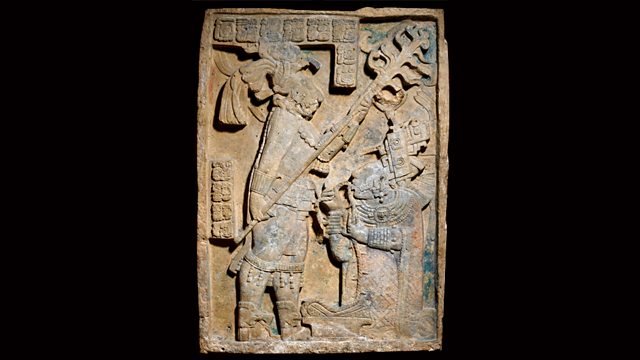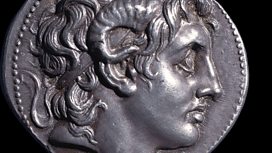Maya relief of royal blood-letting
Neil MacGregor's history of the world as told through objects. Today - power, pain and belief in the world of the ancient Maya
The history of the world as told through objects. This week Neil MacGregor, the Director of the British Museum, is exploring power and intrigue in the great royal courts of the world around 800 AD. Today's object offers a story of authority, pain and belief from the world of the ancient Maya. It is a limestone carving showing a king and his wife engaged in an agonising scene of ritual bloodletting. Neil describes a great city in the jungle of modern day Mexico and the culture that produced it. Virginia Fields, the expert on Maya iconography, and the psychotherapist Susie Orbach help explain an object that has the power to unsettle the modern viewer.
Producer: Anthony Denselow
Last on
More episodes
Previous
You are at the first episode
![]()
More programmes from A History of the World in 100 Objects related to leaders & government
About this object
Location: Mexico
Culture: Aztec, Maya and Central America
Period: AD 600-900
Material: Paint and Stone
��
This lintel from the doorway of a Maya temple depicts a royal blood-letting ceremony. King Shield Jaguar III stands facing his wife, Lady Xook, as she pulls a rope embedded with thorns through her tongue. She is undertaking this painful ordeal in order to contact Shield Jaguar's ancestors in the spirit realm. In Maya society, a ruler's power was based on the knowledge gained by communicating with the supernatural world through blood-letting rituals.
Who were the Maya?
The Maya ruled much of Mexico and Central America between AD 250 and 100. Around 60 separate Maya citystates developed - some were bitter enemies, others forged alliances. Bloodletting and human sacrifice was used to mark significant events in the lives of Maya rulers, such as the birth of an heir, accession to the throne and death. The Maya used different calendars to calculate the exact time for these ceremonies, including a sophisticated 52-year cycle, which was part of a larger calculation of time known as the Long Count.
Did you know?
- The Maya calendar has a series of cycles of 52 years each. We are currently in the 13th, which ends 21 December 2012.
Pain
By Susie Orbach, psychotherapist, psychoanalyst, writer
��
If you can create a feeling of pain in the body – and you survive it – you can move into either a state of, not quite ecstasy, but out of the ordinariness, a sense that you, you can transcend, you can do something rather special, whether this comes from denial – not eating – or it comes from blood-letting, cutting, or it comes from extreme physical exercise.
We would call it ‘magical thinking’ in psychoanalytic terms – if I do this, I’m making a deal with myself that something will be ok.
What I find startling about this horrific image is how visible the woman’s pain is. I think in the present day we’ve come to hide our pain. We have the jokes about our capacity for pain but we don’t really show it.
If we examine the practices that we are involved in, they are often practices that if they were examined from outer space, they’d say ‘why would women be involved in these practices?’. . . It’s that women experience their sense of self by doing these things, by enacting them. They give them the sense of their own identity, and I’m sure that was true for her.
In search of Maya women
By Christina Ripullone, Maya researcher
��
This lintel reveals the political intrigues of the Maya Court. In August, AD 709 one of Itzamnaaj Bahlam’s lesser wives, Lady Ik’Skull from neighboring city Calakmul, bore a son, Bird Jaguar IV. This son would later become heir to the Yaxchilan throne. Known as Lintel 24, this carving is inscribed with the date of October, AD 709, may have been a response to this event, advancing the claims to rulership of any male heir Lady Xook, the king’s primary wife, might produce.
The elaborately woven loincloth worn by the king and covered with a knotted k’an cross motif (symbolizing creation and regeneration), draws attention to the king’s biological powers of procreation, with the queen’s finger suggestively pointing towards the central ruffling and the remainder of the rope, soon to be ritually consummated with Lady Xook’s own blood, dangling nearby.
The ancient Maya landscape was dotted with cities competing for natural resources, political and economic power and the favour of the gods, creating an elaborate network of allies and enemies.
The trade and gift of textiles between Maya nobility of different regions cemented diplomatic relationships between competing city-states and helped maintain a distinct visual vocabulary of the noble class. Just as inter-marriage was a more peaceful alternative to a military campaign, so too was the system of tribute giving, which revolved around the production of textiles. Consequently, control over textile production was a major source of the nobility’s wealth and influence.
Elite women of the ancient Maya, like Lady Xook who is depicted in this lintel, would have been responsible for the manufacture of fine textiles. The basic equipment for weaving was the back-strap loom, which was attached to the weaver for easy portability. One end of the loom would have been attached to the woman’s hips, and the other end would have been tautly secured around a vertical post.
In both the modernday and the ancient Maya, it’s possible to draw a line between a woman’s role as weaver and her role as procreator. Both roles featured women as creators. In a near parallel to the birthing process, the arrangement of the back-strap loom resulted in the piece of cloth physically growing outward from the weaver’s body as it was woven.
A third role of women as creators is evident in the bloodletting ritual depicted in this lintel. While bloodletting was not the exclusive domain of women, the notion of drawing blood out of the body can be interpreted as mimicking the gods’ creation of the universe through their own blood. In fact, the needles used for bloodletting bore a stark similarity to those used for weaving, with the exception being that the needle used to puncture the skin was sharper than the one used for weaving.
Of course women not only wove the textiles that helped maintain political relationships, they married and bore political actors, too.
Transcript
Broadcasts
- Mon 14 Jun 2010 09:45������̳ Radio 4 FM
- Mon 14 Jun 2010 19:45������̳ Radio 4
- Tue 15 Jun 2010 00:30������̳ Radio 4
- Mon 14 Jun 2021 13:45������̳ Radio 4
Featured in...
![]()
Leaders and Government—A History of the World in 100 Objects
More programmes from A History of the World in 100 Objects related to leaders & government
Podcast
-
![]()
A History of the World in 100 Objects
Director of the British Museum, Neil MacGregor, retells humanity's history through objects





